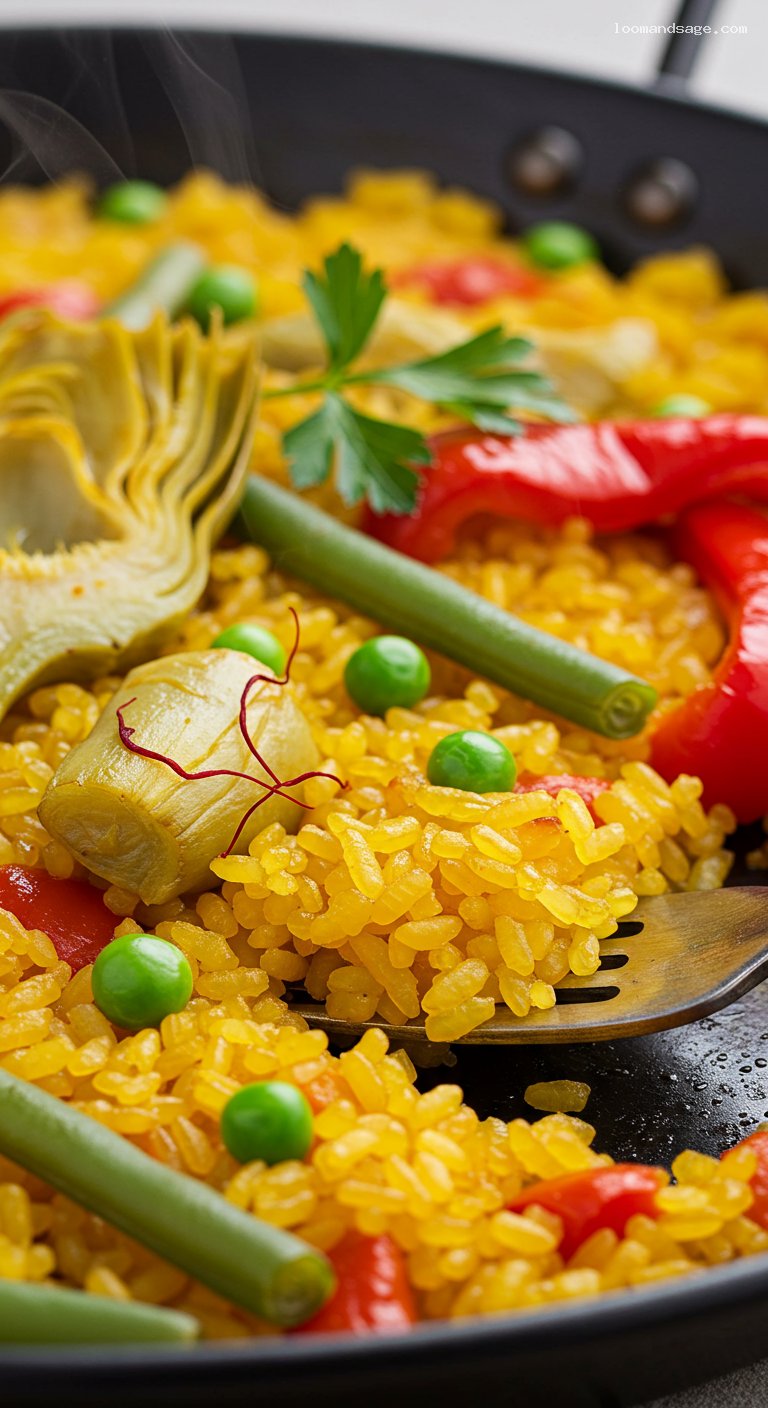Quick Recipe Version (TL;DR)
Quick Ingredients
- 6 1/2 cups low-sodium vegetable broth
- 1/2 tsp saffron threads
- 1/4 cup extra-virgin olive oil
- 1 medium yellow onion, finely chopped
- 5 garlic cloves, minced
- 1 1/2 cups grated ripe tomatoes (or 14 oz crushed, drained)
- 2 cups bomba (or Calasparra) rice
- 1 tsp smoked paprika
- 1/2 cup dry white wine (optional)
- 1 1/2 cups quartered artichoke hearts, drained
- 6 oz green beans, 2-inch pieces
- 1 cup roasted red pepper strips
- 1 cup frozen peas
- 1 bay leaf
- 2 tsp kosher salt (Diamond Crystal; use 1 1/4–1 1/2 tsp if Morton)
- 1/2 tsp black pepper
- Lemon wedges and 1/2 cup chopped parsley, for serving
Do This
- 1. Warm broth with saffron and bay leaf to a bare simmer; keep hot.
- 2. Sauté onion in oil until translucent; add garlic, then tomatoes; cook until jammy. Stir in smoked paprika.
- 3. Add rice; toast 1–2 minutes. Season with salt and pepper. Deglaze with wine; spread rice in an even layer.
- 4. Pour in 6 cups hot broth; nestle in artichokes and green beans. Boil vigorously 8–10 minutes; do not stir.
- 5. Reduce to medium-low; scatter peppers and peas. Simmer 8–10 minutes until liquid is mostly absorbed and rice is tender, adding reserved 1/2 cup broth if needed.
- 6. Socarrat: raise heat 60–90 seconds until you hear a gentle crackle and smell toasty aromas. Remove from heat.
- 7. Rest 5–8 minutes under a clean towel. Finish with lemon and parsley. Optional oven finish: bake at 425°F for the last 8–10 minutes instead of simmering.
Why You’ll Love This Recipe
- Classic saffron-scented paella flavor with a crisp socarrat bottom, no special equipment required.
- Loaded with vegetables for a colorful, plant-forward main that still feels luxurious.
- Clear, timing-based cues so your rice cooks evenly and never turns mushy.
- Flexible method: finish on the stovetop or in the oven depending on your setup.
Grocery List
- Produce: 1 medium yellow onion, 1 head garlic, 3 ripe tomatoes (or canned), 1 lemon, 1 bunch flat-leaf parsley, 6 oz green beans
- Dairy: None
- Pantry: Bomba/Calasparra rice, low-sodium vegetable broth, saffron threads, smoked paprika, extra-virgin olive oil, bay leaf, kosher salt, black pepper, roasted red peppers (jarred), artichoke hearts (jarred or frozen), frozen peas, dry white wine (optional)
Full Ingredients
Saffron Broth
- 6 1/2 cups (1.54 liters) low-sodium vegetable broth
- 1/2 tsp saffron threads (about 0.5 g), lightly crushed
- 1 bay leaf
Sofrito and Rice
- 1/4 cup (60 ml) extra-virgin olive oil, plus 1 tbsp for socarrat if needed
- 1 medium yellow onion (about 180 g), finely chopped
- 5 garlic cloves (about 20 g), minced
- 1 1/2 cups (360 g) grated ripe tomatoes with juices (or 14–15 oz canned crushed tomatoes, drained to 1 1/2 cups)
- 2 cups (360 g) bomba or Calasparra rice
- 1 tsp (2 g) smoked paprika (pimentón de la Vera)
- 1/2 cup (120 ml) dry white wine (optional)
- 2 tsp kosher salt if using Diamond Crystal; if using Morton, use 1 1/4–1 1/2 tsp
- 1/2 tsp freshly ground black pepper
Vegetables and Finish
- 1 1/2 cups (200 g) quartered artichoke hearts, well drained (jarred in brine or thawed frozen)
- 6 oz (170 g) green beans, trimmed and cut into 2-inch pieces
- 1 cup (120 g) roasted red pepper strips (piquillo or pimientos), drained
- 1 cup (140 g) frozen peas
- 1 lemon, cut into 8 wedges
- 1/2 cup (15 g) finely chopped flat-leaf parsley
Optional
- Pinch of red pepper flakes for gentle heat
- Flaky sea salt for finishing

Step-by-Step Instructions
Step 1: Warm the saffron broth
In a medium saucepan, combine the vegetable broth, saffron threads, and bay leaf. Bring just to a bare simmer over medium heat, then reduce to low to keep the broth hot (aim to keep it around a gentle 180–190°F). Hot broth ensures even cooking and helps the rice absorb flavor. Keep this on the back burner while you cook the paella.
Step 2: Preheat and prepare your pan
If you plan to finish in the oven, preheat to 425°F (220°C). Set a 14–15 inch paella pan or a wide 12-inch heavy skillet over medium heat. Add the olive oil and let it warm until shimmering but not smoking.
Step 3: Build a jammy sofrito
Add the chopped onion and cook, stirring, until translucent and lightly golden, 5–7 minutes. Add the minced garlic and cook until fragrant, about 30 seconds. Stir in the grated tomatoes and cook, stirring occasionally, until the mixture thickens into a deep, jammy paste, 6–8 minutes. Sprinkle in the smoked paprika (and red pepper flakes if using) and cook 30 seconds to bloom the spices.
Step 4: Toast and season the rice
Add the rice and stir to coat every grain in the sofrito and oil; toast 1–2 minutes until the rice looks glossy. Season with the kosher salt and black pepper. Pour in the white wine (if using) and cook, stirring, until it has mostly evaporated, 1–2 minutes. Using a spatula, spread the rice mixture into an even layer across the pan.
Step 5: Add saffron broth and arrange vegetables
Carefully pour in 6 cups of the hot saffron broth, reserving the remaining 1/2 cup. Bring to a vigorous boil over medium-high heat. Evenly scatter the artichoke hearts and green beans over the rice. From this point on, do not stir the rice. Let it boil briskly for 8–10 minutes, rotating the pan occasionally for even cooking. You should see small bubbles across the surface.
Step 6: Finish the rice and add peas and peppers
Reduce the heat to medium-low (or transfer to the 425°F oven) and scatter the roasted red pepper strips and peas over the top, nudging them gently so they settle into the liquid. Cook at a gentle simmer for 8–10 minutes longer, until the liquid is mostly absorbed and the rice is tender with just a slight bite. If the pan looks dry before the rice is done, add the reserved 1/2 cup hot broth in a few splashes.
Step 7: Create the socarrat and rest
To develop the prized socarrat (the crisp layer of rice at the bottom), increase the heat to medium-high for 60–90 seconds. Listen for a soft crackling and watch for a toasty aroma. Peek by sliding a thin spatula down one edge; you’re looking for a thin, golden-brown crust. If you smell anything acrid, stop immediately. Remove from heat, cover the pan loosely with a clean kitchen towel, and rest 5–8 minutes to finish steaming.
Step 8: Finish and serve
Remove the bay leaf. Squeeze 1–2 lemon wedges over the paella and sprinkle with chopped parsley. Taste and adjust salt if needed. Serve directly from the pan with extra lemon wedges and a pinch of flaky sea salt.
Pro Tips
- Do not stir after the broth goes in. This keeps the rice from turning creamy and helps the socarrat form.
- Keep the broth hot the entire time. Adding cold liquid stalls cooking and can make grains uneven.
- Pan size matters. Aim for a thin rice layer (about 1/2 inch). If your pan is smaller, cook in two batches or scale the recipe down.
- Season smartly: 2 tsp Diamond Crystal kosher salt equals about 1 1/4–1 1/2 tsp Morton. Adjust if your broth is saltier.
- Jarred artichokes and roasted peppers vary in acidity; pat dry and taste them. If very tangy, rinse lightly and drain well.
Variations
- Spring Green Paella: Swap green beans for asparagus and add shelled fava beans; finish with tender pea shoots.
- Woodland Mushroom Paella: Sear 12 oz sliced mixed mushrooms in the oil first until browned; remove, then make the sofrito. Nestle mushrooms back in with the artichokes.
- Oven-Finished Method: After Step 5, transfer the pan to a 425°F oven for 10–12 minutes until the rice is nearly tender, then return to the stovetop for 60–90 seconds to build socarrat.
Storage & Make-Ahead
Make the sofrito (onion, garlic, tomato, paprika) up to 3 days ahead; refrigerate in an airtight container. Leftover paella keeps 3–4 days refrigerated. Reheat in a skillet over medium heat with a splash of broth or water; cover to steam 3–5 minutes, then uncover and cook 1–2 minutes to re-crisp the bottom. Freezing is possible for up to 1 month, though the rice will soften slightly upon thawing.
Nutrition (per serving)
Approximate values: 400 calories; 55 g carbohydrates; 10 g fat; 9 g protein; 6 g fiber; 520 mg sodium. Calculated for 6 servings using 1/4 cup olive oil and low-sodium broth; wine optional. Values are estimates.


